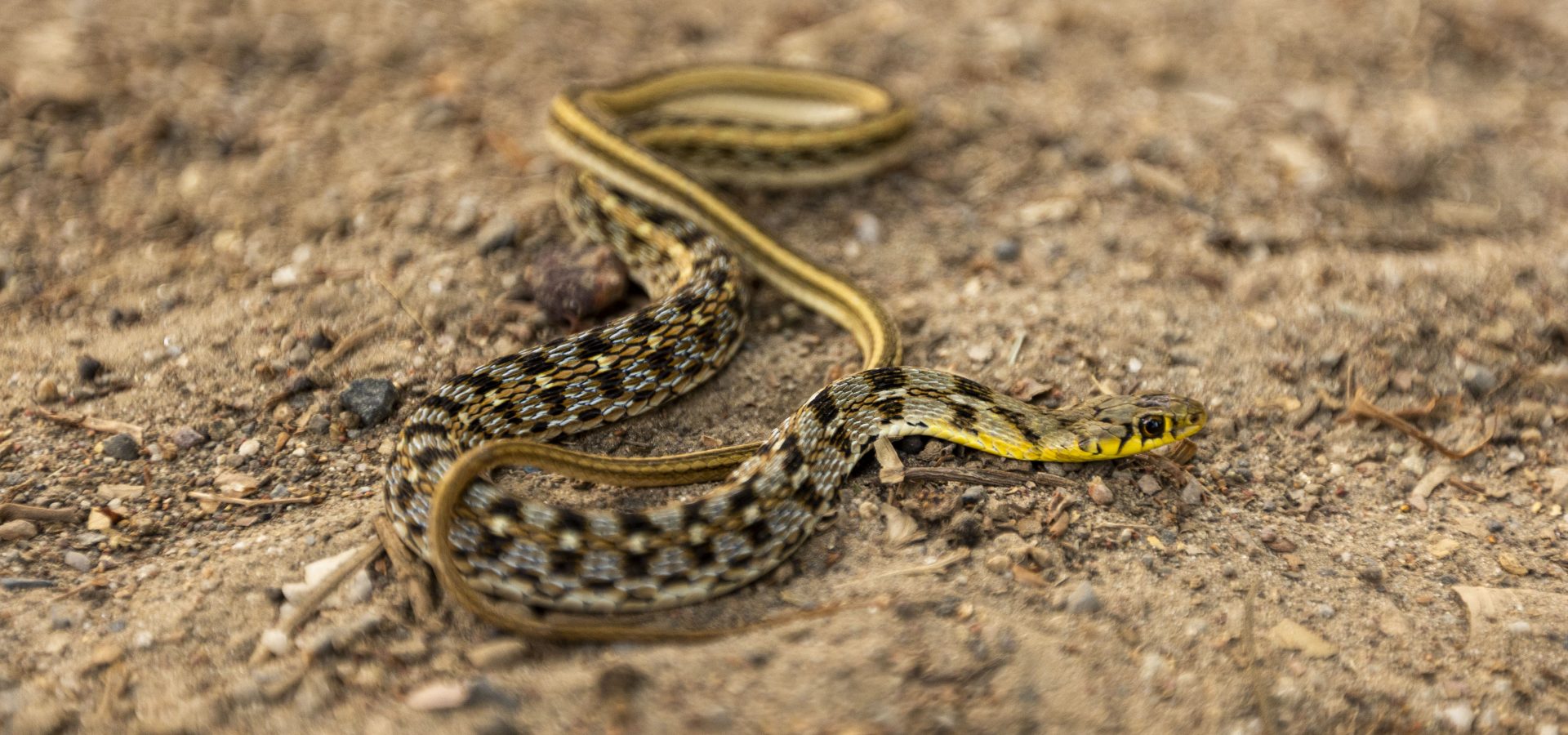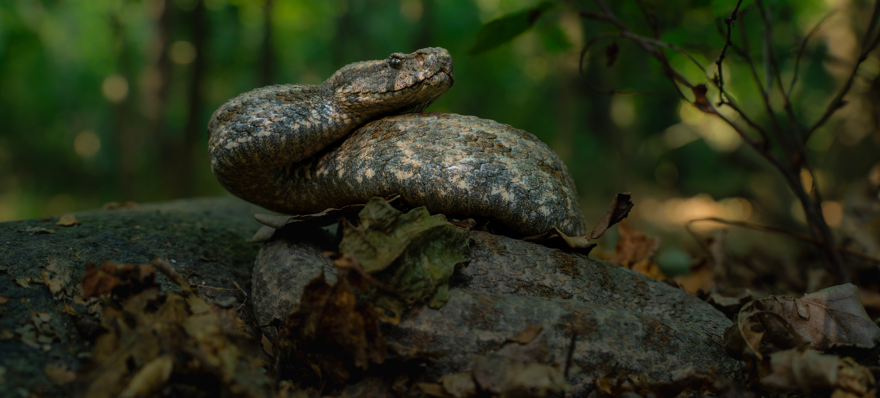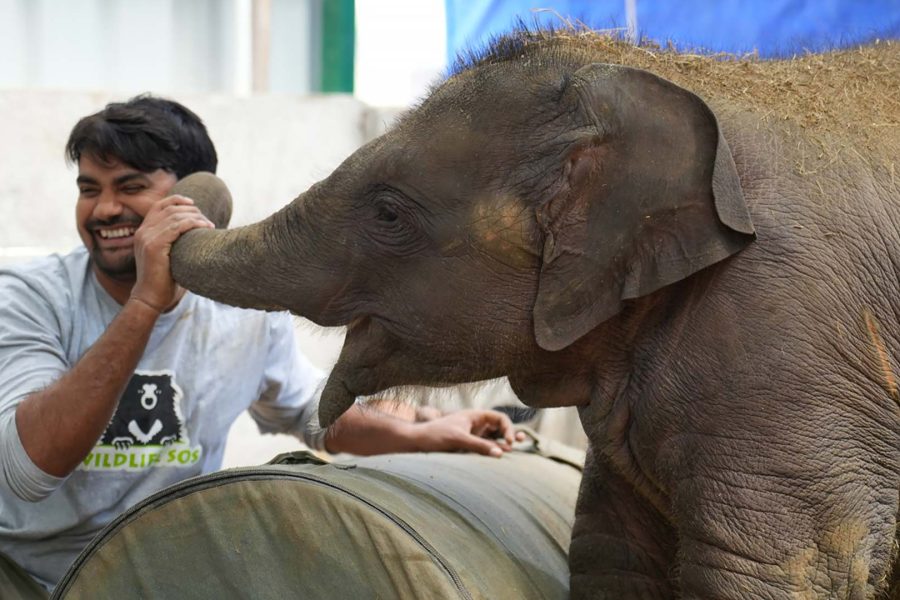Wildlife SOS Rapid Response Unit carries out rescues from the most unexpected places, and of the most unusual species. They rescued over 300 reptiles from in and around Agra city in the months of September and October alone! Most commonly found reptiles include venomous snakes like the Spectacled cobra and Common kraits and non-venomous ones like the Indian Wolf snake and the Indian Rat snake. But here are some not-so-commonly-known snakes that our team has rescued over the years!
Vipers
One of the most dreaded reptiles, these venomous snakes occupy a variety of landscapes, including human-dominated regions. The Wildlife SOS Rapid Response team has rescued several viper species around the country — from the high-altitude areas of Jammu to the heat-stricken lands of Delhi NCR.
- Russell’s viper
A viper species that our Rapid Response Unit rescues is the Russell’s viper (Daboia russelii). Recently, a local vendor spotted the snake near a canal (‘nala’) in South Delhi and immediately informed our helpline. Having had years of experience, the rescuer handled the snake with the utmost caution, as these snakes react violently to being picked up, and also can bite with a snap. The fangs of Russell’s viper are the largest in length among Indian snakes. The snake was safely transferred into a snake bag and kept under medical observation, until deemed fit to release by our veterinarians.
- Levantine viper
With the species distributed across Jammu and Kashmir, our team operating out of the state receives numerous calls from locals to rescue Levantine vipers. The Levantine viper (Macrovipera lebetina) also known as ‘gunas’ in the local language, is a venomous snake, which is capable of making fast strikes when provoked. Sometimes they have been spotted sunbathing in the backyard of houses and in another instance, an individual was found taking refuge at a wedding event!
- Saw-scaled viper
Known for its strongly keeled scales, ‘S’- shaped body, and stridulation that sounds like a working saw machine, the Saw-scaled viper (Echis carinatus) is one of the ‘Big Four’ venomous snakes in India. Its venom is highly toxic since it can impede blood clotting while also damaging body cells and tissues. The snake is hard to spot as it camouflages itself well within the surroundings, and moves smoothly using the sidewinding technique. With professional expertise to handle highly venomous snakes, the Wildlife SOS team has been able to safely rescue Saw-scaled vipers spotted in Delhi NCR.
Himalayan Trinket
The Himalayan trinket (Orthriophis hodgsonii) is found in North India, spread across the Garhwal Himalayas of Uttarakhand, Jammu and Kashmir, Himachal Pradesh, West Bengal, Sikkim, and Meghalaya. It is a non-venomous snake species which remains understudied and has not yet been assessed by the International Union for Conservation of Nature (IUCN) Red List. However, rapid urbanisation, shrinking of natural water resources inside protected areas and lack of awareness among locals are some of the threats which can impact the population of this snake.
The Wildlife SOS team in Jammu and Kashmir has rescued Himlayan trinket snakes on several occasions. One afternoon, students of Government Girls’ High School spotted a four-foot-long snake stuck in the boundary wall of the premises. In another incident, a six-foot-long trinket snake was found by a family, hidden in the thick foliage of their backyard lawn. Another Himalayan trinket was rescued by our team from behind the refrigerator of a house in Jammu. All the snakes were released back into their natural habitat after a medical examination by our team.
Bronzeback Tree Snake
Bronzeback tree snakes (Dendrelaphis tristis) are found throughout India, except in the northeastern states. A non-venomous species, it has a long, slender body with a wide bronze stripe running throughout its length. Being arboreal, it can mostly be spotted on top of trees or dense bushes. When threatened, the reptile inflates its neck and displays a bright blue interscale pattern.
A few years ago, a Bronzeback tree snake found in a congested residential area in Delhi was rescued from a tree by our rescue team. The reptile was kept under medical observation and released back into its natural habitat once deemed fit by our veterinary team. Our team based out of Agra also successfully rescued six Bronzeback snakes from a human-dominated landscape in 2017, after receiving a call from a panic-stricken citizen.
Eastern Cliff Racer
The next snake on the list is the rather elusive Eastern cliff racer (Platyceps ladacensis). This long, slender snake, with a maximum length of three and a half feet, has dark bands across the body and a white underside. Generally active during the day time, it is found near rocky areas, cliffs, and sometimes in human-dominated areas. Two juveniles of the mildly venomous snake were recently rescued by our team from residences in the Rainawari locality of Srinagar, the capital city of Jammu and Kashmir. The snakes were carefully extricated and released back into their natural habitat after a thorough medical examination.
A few years ago, an Eastern Cliff racer snake was rescued by our team from the garden of a resident in Jammu and Kashmir. Anxious residents were taken aback and had begun evacuating their homes. Our rescuers rushed to the spot and extricated the snake after a two-hour-long search! The reptile was then taken to the nearby forest, where it was carefully released.
Keelbacks
- Buff-striped keelback
Buff-striped keelback (Amphiesma stolata) is a non-venomous, mid-sized reptile growing up to the length of two feet. With body colour ranging from olive-brown to grey, the snake has two distinct yellow stripes along its length. It is a widely distributed snake across Asia and Southeast Asia.
In several incidents, the Wildlife SOS Rapid Response Unit has rescued Buff-striped keelback snakes from human-dominated landscapes. A few months ago, staff at a school in Vadodara, Gujarat was left bewildered when they found a total of eight Buff-striped keelback snakes on the premises. Concerned for the safety of the students, the authorities immediately informed our helpline, operating in collaboration with the GSPCA. The snakes were found coiled up inside a water storage tank, and by exercising extreme caution, the team safely extricated the snakes. Although rarely sighted in Delhi, in May 2022, our team rescued another Buff-striped keelback from a residential society.
- Green keelback
Green keelback (Rhabdophis plumbicolor) is a non-venomous reptile inhabiting the lands of the Indian subcontinent. This medium-sized snake averages two feet in length and has a green or yellowish-green body covered with highly keeled scales, and a distinct ‘V’- shaped marking is present on its neck. While juveniles are identified by being brightly coloured with bands, adults have lighter or no markings on their bodies.
A few years back, our team successfully rescued a Green keelback which was taking shelter between the crannies of a boundary wall at a house in Agra. Equipped with rescue gear, our team carefully extricated the snake — ensuring it suffers no injuries. After the rescue, the keelback was kept under medical observation and was released back into its natural habitat once deemed fit by our veterinarians.
Streaked Kukri Snake
Also known as Russell’s kukri snake (Oligodon taeniolata), this species is a non-venomous colubrid found in parts of the Indian peninsular region. While the reptile is brownish in colour, it has a pattern of black streaks from head to tail. It gets its name from the shape of its curved teeth which resemble a ‘kukri’ (or knife) that helps it to slit open reptile eggs it feeds on.
Over the years, Wildlife SOS has rescued several kukri snakes from urban spaces. Two years ago, our Rapid Response team rescued a Streaked kukri from a house in Delhi NCR. The snake was kept under medical observation and was released back into the wild once deemed fit. In August this year, our Uttar Pradesh team also rescued a Banded kukri snake.
Working round-the-clock, our team responds to multiple reptile rescue calls every day and also organises several awareness programmes and workshops to impart knowledge and sensitise people. With requisite equipment and protective gear, the Wildlife SOS Rapid Rescue team employs extreme stealth and caution while extricating these animals. Rescued reptiles are kept under medical observation and released back into their natural habitat once they are deemed fit by our veterinary team.
Our units are established in the following regions and can be reached out for assistance on the following helpline numbers:
Delhi NCR – +91 9871963535
Agra and Mathura, Uttar Pradesh – +91 9917109666
Vadodara, Gujarat – +91 9825011117
Jammu & Kashmir – +91 7006692300, +91 9419778280
To keep up with reptile information and all of our unique reptile rescues, make sure to follow our Facebook Reptile group!





